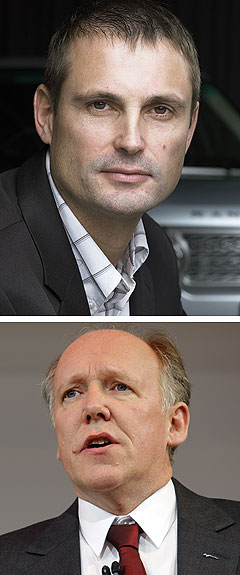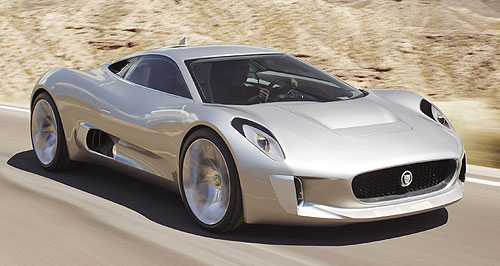Make / Model Search
Future models - Jaguar - C-X75Jaguar C-X75 up in the airVicious cat: The petrol-electric powertrain in the Jaguar C-X75 points the way forward to the technology we might see in green volume Jags of the near future. No production green-light yet for ballistic plug-in Jaguar C-X75 prototype supercar23 Oct 2012 By HAITHAM RAZAGUI and MIKE COSTELLO DEVELOPMENT of the radical $1.35 million Jaguar C-X75 plug-in hybrid supercar is less advanced than previously thought, with the British-based company yet to give the green light for the coupe to progress beyond running-prototype stage to full production. The remarkable C-X75 – which features an manic F1-inspired 1.6-litre twin-charged 375kW petrol engine and electric motors on each axle – had been slated for a 200-unit production run in 2014, with two cashed-up Australian buyers expressing firm expressions of interest. But while Jaguar confirms it has four or five working test-runners in action developed with Formula One team Williams, further development looks to have been placed on the back-burner as the company places more focus on growing its current range and creating more mainstream models. Jaguar Land Rover global director of group sales operations Phil Popham was in Sydney for last week’s Australian International Motor Show opening and told GoAuto decisions on the C-X75’s future would be made in the coming months. “We've got a lot of priorities at the moment at JLR – the F-Type being one of them – and we're spending between the companies around 2 billion pounds on new product development and expanding around the world, and we've got some priorities to make,” he said. “That decision (on the future of C-X75) we'll make in the coming months, but our real focus at the moment is expanding around the world and growing the product range that we've got.  From top: JLR global director of group sales operations Phil Popham Jaguar design director Ian Callum. From top: JLR global director of group sales operations Phil Popham Jaguar design director Ian Callum.“We're not saying we won't be bringing it to market, we'll still develop it as a car and it’s running around the track at the moment. It will still go on-sale at some point.” As Reported in July, the company has said its projected 200-unit production run had all been “snapped up”. Stressing the importance of extreme vehicles like the C-X75 to the company was Jaguar design director Ian Callum, who told media on the eve of the Sydney show that it was vital to get the message out that JLR is capable of producing cars “as unique and good as this”. “Can we compete with McLaren or Porsche? Yes we can,” he said. Regardless of when that happens, Mr Popham said the company would also look to use the radical powertrain technology developed for the C-X75 in more mainstream models of the future. "Core technology has been developed – that was the main reason for doing C-X75 – to actually demonstrate to the world that we are on the leading edge of technology, and sustainable technology as well whether it be lightweight and hybrids,” he said. Mr Callum said that “hybrid will be very important for us and its important for the industry”, while adding that the C-X75 had a “distinct electric sound” because people did not want the “guilty indulgence” of a loud supercar. “If you want a V8, but an HSV,” he joked. Jaguar’s ambition with the C-X75 prototypes is slightly lower than for the original concept first shown at the 2010 Paris motor show, in which twin miniature gas turbines were used to generate electricity. In a move echoing of its previous supercar effort – the short-lived XJ220 originally shown with a V12 engine and all-wheel-drive but produced with a twin-turbo V6 and rear-wheel-drive – Jaguar ditched the turbines in favour of a highly-strung four-cylinder petrol engine and two electric motors. The turbocharged and supercharged unit supplements a motor placed on the rear axle, either driving the rear wheels directly or charging the batteries. A fast-acting supercharger provides boost at low revs, with the turbo kicking in further up the rev band. A separate electric motor located at the front provides constant power flow to the front wheels via a separate transmission, giving the C-X75 all-wheel drive. Jaguar projects the C-X75 prototypes can sprint from 0-100km/h in 3.0 seconds and consume as little as 4.0L/100km. “People aren’t willing to pay to be green unless there is some other demonstrative aspect,” said Mr Popham, with that aspect in this case being extreme speed. These figures would put the C-X75 in the same performance ballpark as Porsche’s forthcoming and equally expensive 918 plug-in hybrid. Ferrari is also reportedly set to follow the trend of green supercars with a petrol-electric powertrain for its imminent Enzo-replacing flagship. Despite being a conceptually similar in layout to the single-engine/twin-motor Porsche 918, Mr Callum said the JLR system was a different beast and worked “at levels nobody’s seen before”. For instance, the “hugely ambitious” system has an engine with a stratospheric 10,000rpm redline. Mr Callum said the C-X75 concept’s turbines have not been ditched for good and are still in development for use in future vehicles, describing the project as “beneficial due to the technology being developed”. However he said the turbines were “a bit ambitious” and “a step too far” for the C-X75 project but that Jaguar is still working on using them as generators. He said that Ratan Tata, chairman of the Indian conglomerate Tata which owns JLR, bought shares in turbine manufacturer Bladon Jets to produce remote location generators for developing countries.  Read moreAll future models Alfa Romeo Alfa Romeo Abarth Abarth Alpine Alpine Alpina Alpina Audi Audi Aston Martin Aston Martin BMW BMW Bentley Bentley Chery Chery Brabham Brabham Chrysler Chrysler Chevrolet Chevrolet Cupra Cupra Citroen Citroen DS DS Dodge Dodge Fiat Fiat Ferrari Ferrari Foton Foton Ford Ford Great Wall Great Wall FPV FPV Haval Haval GWM GWM Honda Honda Holden Holden Hummer Hummer HSV HSV Infiniti Infiniti Hyundai Hyundai Jaguar Jaguar Isuzu Isuzu Kia Kia Jeep Jeep Land Rover Land Rover Lamborghini Lamborghini Lexus Lexus LDV LDV Mahindra Mahindra Lotus Lotus Mazda Mazda Maserati Maserati Mercedes-AMG Mercedes-AMG McLaren McLaren MG MG Mercedes-Benz Mercedes-Benz Mitsubishi Mitsubishi Mini Mini Opel Opel Nissan Nissan Peugeot Peugeot Pagani Pagani Proton Proton Porsche Porsche Renault Renault Ram Ram Rover Rover Rolls-Royce Rolls-Royce Skoda Skoda Saab Saab SsangYong SsangYong Smart Smart Suzuki Suzuki Subaru Subaru Toyota Toyota Tesla Tesla Volvo VolvoMotor industry news |
Click to shareJaguar modelsResearch Jaguar All future models Alfa Romeo Alfa Romeo Abarth Abarth Alpine Alpine Alpina Alpina Audi Audi Aston Martin Aston Martin BMW BMW Bentley Bentley Chery Chery Brabham Brabham Chrysler Chrysler Chevrolet Chevrolet Cupra Cupra Citroen Citroen DS DS Dodge Dodge Fiat Fiat Ferrari Ferrari Foton Foton Ford Ford Great Wall Great Wall FPV FPV Haval Haval GWM GWM Honda Honda Holden Holden Hummer Hummer HSV HSV Infiniti Infiniti Hyundai Hyundai Jaguar Jaguar Isuzu Isuzu Kia Kia Jeep Jeep Land Rover Land Rover Lamborghini Lamborghini Lexus Lexus LDV LDV Mahindra Mahindra Lotus Lotus Mazda Mazda Maserati Maserati Mercedes-AMG Mercedes-AMG McLaren McLaren MG MG Mercedes-Benz Mercedes-Benz Mitsubishi Mitsubishi Mini Mini Opel Opel Nissan Nissan Peugeot Peugeot Pagani Pagani Proton Proton Porsche Porsche Renault Renault Ram Ram Rover Rover Rolls-Royce Rolls-Royce Skoda Skoda Saab Saab SsangYong SsangYong Smart Smart Suzuki Suzuki Subaru Subaru Toyota Toyota Tesla Tesla Volvo VolvoMotor industry news |










Facebook Twitter Instagram